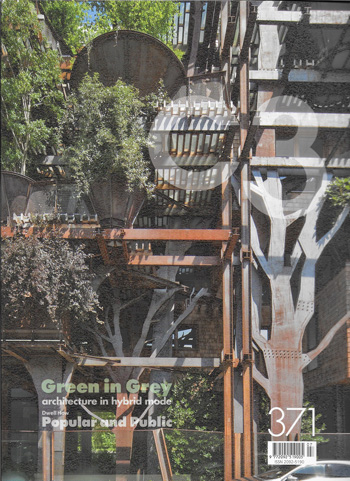Title: C3; #371 Green in Grey
Managing Editor: YuMi Hyun
Photographer/s: Boegly, Luc; Boutin, Vincent; Carrieri, Mario; Denancé, Michel; Giardino, Beppe; Fessy, Georges; Grazia, Sergio; Kryński, Wojciech; Menges, Simon; Navarro, Jaime; Oki, Hiroyuki; Piazza, Matteo; Rosselli, Paolo; Soistier, Julie; Weiner, Cyrille.
Photography courtesy of: Many photos courtesy of the architect.
Editor(s): HyoJin Jeon, SeungRi Yoo, SeYeon Kim and HyeJung Gwon.
Research Assistant:
ISSN: 2092-5190
Size: 300mm by 226mm, 200p.
Publisher: JaeHong Lee.
Publisher www: www.c3p.kr

A monthly magazine from Korea, C3 looks at thematically linked architectural projects from around the world. #371 from August 2015 has two themes; the integration of nature and greenery into urban buildings and the blending of the public space into buildings.
C3 has an extensive variety of case studies and provides a large number of images for each. The text is written in both English and Korean, which doubles the amount of space for each case study and thus necessitates extra photographs. The layout of the magazine focuses mainly on these photos, with lots of bleed, full bleed and pages of blueprints and floor plans, giving a great sense of each building. The text, due to being printed twice, is not all encompassing but does give a good sense of each building to support the images.
There is a significant issue with C3 is that the level of English sometimes can be difficult to read. The translation from Korean to English is usually of a fair standard, but does run into some issues in the latter half of the magazine.
The first section, “Green in Grey”, shows buildings that are linked through using living wood as an integral part. The apartment buildings and inner-urban commercial structures look almost unrecognisable when coated in a layer of living greenery, and sometimes the trees can be tied into the purposes of the building itself. An example of this is in the Primary School for Sciences and Biodiversity (22) in Boulogne-Billancour, France. This school, predominantly built in concrete, includes a rooftop garden in three sections for education. The exterior wall, while in concrete, is also designed to provide shelter for nesting fauna and flora. Some blend their facades with the outer world through greenery such as in the Green Renovation, Vietnam (66) and in the Falcón Headquarters 2, Mexico City (72). Some buildings even surpass what nature can do, as shown in the Vertical Forest, Milan (96). On a block of 1500m2, the building houses the equivalent of over 20,000m2 of forest and undergrowth, presenting an almost completely green exterior reaching up into the sky.
The second section, “Popular and Public”, looks at ways in which buildings can bring the public space can be blended with their private interiors, mostly involving public buildings such as theatres or museums. These buildings are all predominantly constructed from concrete disappointingly, but in bringing in the public some of the buildings also bring in the environment. The Cricoteka Museum of Tadeusz Kantor, Krakow (162) uses a mirror mounted on a courtyard roof to float the Vistula River above the public, enveloping them in the waters. Another even more impressive design is that of the Gdansk Shakespearean Theatre in Gdansk, Poland (178), where the roof of the theatre above the stage can open entirely, bringing the sun and wind directly into the theatre.
C3 showcases some of the most interesting architectural projects from around the world, and the themes that it explores in each issue are widespread to be of interest to any reader. The quality of the articles and images are top tier, and though there is an issue with the level of English at times, the magazine does a fine job of presenting excellent designs in a beautiful format.
